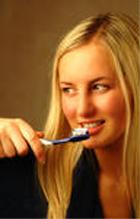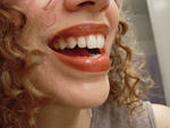|
"I had very good dentures once. Some magnificent gold work. It's the only form of jewelry a man can wear that women fully appreciate." Graham Greene |
|
Modern dentistry

Sparkle your smileMost people know that the teeth are the hardest and strongest part of the body. There's more than meets the eye, though. Teeth are actually a living part of your body that has blood vessels and nerves. If you used to judge your teeth like a book by its cover, then you're in for one big surprise. Teeth anatomy is a lot more complicated than you ever thought. The visible part of a tooth, otherwise known as the crown, is only a small portion of the living system. The crown is made up of enamel, the hardest substance found within the body. It is bone that has been enriched with large percentages of calcium. That's why people who drink lots of milk or take calcium supplements have strong bones and teeth. The enamel is thickest at the crown, and thinnest near the roots of the teeth. Excellent crowns and bridges were made by the Etruscans in the 7th cent. B.C. At about that time, teeth were being extracted in Asia Minor as a cure for bodily ills and diseases. Skills achieved by the Etruscans, Phoenicians, Egyptians, Greeks, and Romans were largely lost during the Middle Ages, when barbers and roving bands of charlatans practiced unskilled dentistry at marketplaces and fairs. Abulcasis, a Spanish Moor, was one of the few in his time who studied dental surgery. Methods of teeth straighteningLingual braces are similar to classic orthodontic braces but are attached to the backside of the teeth, rather than the front. Although they still have many of the problems of standard braces, they are not visible and may be chosen by adults who do not wish for visible braces. Lingual braces are more expensive than standard braces but the fastest method of "invisible" teeth straightening. The most common method of teeth straightening remains standard orthodontic braces. Archwires, springs, and rubberbands apply pressure to the individual teeth by means of brackets that are glued onto their surface. Regular visits are required to the orthodontist in order to tighten wires as needed and make other adjustments. At each visit, the wires will be tightened slightly to renew pressure and push them toward their intended position. Additional wires, rubberbands, and headgear may be prescribed to help move the teeth into their ideal position as quickly as possible. When the teeth have all been repositioned, the brackets will be removed and a retainer must be worn to prevent relapse for some period of time. Learning more about dental implantsTooth loss is something no one looks forward to. If you lose one or more teeth, you have a number of options, one of which is dental implants. You owe it to yourself to be informed as possible about these options. With this in mind, we've created this section on dental implants. Begin learning more about dental implants for tooth replacement exacltly now! Implants are surgically placed in your jaw bone while under anesthesia. It is a very time consuming procedure when having many implants placed. As this procedure is surgical, it is very important to research and find a well credited cosmetic dentist that you are comfortable with. For some people there are varying degrees discomfort or pain, which subsides in a couple of days. As with similar types of surgery, bruising and minor swelling might also develop shortly after the procedure. The implant procedure is a surgical placement of the implant or implants in your jaw bone which requires a three to six month healing period before the implant restoration to replace the missing tooth or teeth. During this healing time, the bone grows in and around the titanium implant creating a very strong support. Dental implants can be rejected. Usually they are replaced with another implant of a slightly larger size. The rejection or "failure" rate is minimal, only 1 to 2% of all implant procedures. You must go without wearing your dentures for one day to two weeks after an implant placement. After the implant has "taken" and you have sufficiently healed, a very natural crown is placed on the implant. If you're missing one tooth or all of your teeth, implants may well be for you. So long as you have enough bone in the area of the missing tooth to facilitate the anchorage of the implants, this procedure can yield terrific results. If you don't have enough bone for this purpose, a bone graft may be necessary. A procedure of building up the bone is known as Bone Grafting. Bone grafting is common with dental implants. The bone that is used is one of three types. The preferred bone to use is taken from other areas of your mouth or collected in a suction device as the drilling of the sites for dental implants occurs. Sometimes bone is taken from areas such as a hip (this requires an orthopedic surgeon and an operating room). The third source for needed bone is a synthetic type. This is the least preferred type of bone to be used for this procedure. Teeth bridgesIf you a space from a missing tooth, a bridge will be custom made to fill in the space with a false tooth. The false tooth is attached by the bridge to the two other teeth around the space - bridging them together. Your cosmetic dentist will prepare your teeth on either side of the space for the false tooth. You will be given a mild anesthetic to numb the area, and the cosmetic dentist will remove the an area of each abutment (teeth on either side of the space) to accommodate for the thickness of the crown. When these teeth already have fillings, part of the filling may be left in place to help as a foundation for the crown. Your cosmetic dentist may have you use a Flipper appliance. A Flipper is a false tooth to temporarily take the place of a missing tooth before the permanent bridge is placed. A Flipper can be attached via either a wire or a plastic piece that fits in the roof of your mouth. Flippers are meant to be a temporary solution while awaiting the permanent bridge. Teeth dentures procedureDentures, also known as false teeth, are the primary topic in this section of our site. Here, you can learn how the procedure is performed, what dentures cost and the advantages and disadvantages of having them. If you've lost, or are losing, all of your teeth a Complete Denture is something to discuss with your cosmetic dentist. If some of your teeth remain and are healthy, a partial denture may be your way to a great smile. The main component of dentures is acrylic resin molded over the top of various combinations and paterns of metal. In oreder to use dentures all of the teeth in the top or bottom or both top and bottom of the mouth are removed. It is recomended that after the removal of the necessary teeth that the patient wait at least a month to have the dentures fit to the mouth. The waiting period allows for proper healing in the mouth to take place. Dental reshapingFor individuals who have chipped, cracked or irregularly shaped teeth, dental contouring and reshaping can be just the ticket for a more beautiful smile. The dental contouring procedure can even be a substitute for braces under certain circumstances. It is also a procedure of subtle changes. A few millimeters of reduction and a few millimeters of tooth-colored laminate can create a beautiful smile when performed by a cosmetic dentist, with no discomfort to you. Tooth reshaping, or dental contouring, is commonly used to alter the length, shape or position of your teeth. Tooth reshaping, or tooth sculpting, is a safe and conservative way to improve your smile. Teeth may become weaker if large amounts of enamel are removed, tooth reshaping should be limited to minor changes or combined with veneers or bonding for the best smile. Dental reshaping and contouring is a procedure to correct crooked teeth, chipped teeth, cracked teeth or even overlapping teeth in just one session. This procedure is even a substitute for braces under certain circumstances. This is also a procedure of subtle changes. A few millimeters of reduction and a few millimeters of tooth-colored can create a beautiful smile when performed by a cosmetic dentist, with no discomfort to you. Tooth reshaping, or dental contouring, is commonly used to alter the length, shape or position of your teeth. Dental veneersThis section of our cosmetic dentistry information site provides you with some background into dental veneers, both composite veneers and porcelain veneers. Dental veneers, sometimes called tooth veneers, can be used to correct both color and shape problems. There are several corrections that you can make to the color of your teeth as well as the shape of your teeth! Some of the causes of tooth discoloration are staining, aging, chemical damage, disease, medication, and genetics. Dental Veneers (Tooth Veneers) are used to correct both the color and the shape of teeth. Dental veneers (sometimes called porcelain veneers or dental porcelain laminates) are wafer-thin, custom-made shells of tooth-colored materials designed to cover the front surface of teeth. These shells are bonded to the front of the teeth changing their color, shape, size or length and resulting in an improved appearance. Dental veneers can be made from porcelain or from resin composite materials. Porcelain veneers resist stains better than resin veneers and better mimic the light reflecting properties of natural teeth. Resin veneers are thinner and require removal of less of the tooth surface before placement. You will need to discuss the best choice of veneer material for you with your dentist. The need for teeth whiteningThere are many different causes that lead to stained or discolored teeth. Some of the most common causes are everyday foods and drinks--coffee, tea, soda, and red wine all have a staining effect on tooth enamel. Smoking will also darken teeth. Some medications, if taken during early childhood, can result in teeth that are discolored. The simplest type of teeth whitening is the use of products that can be picked up from the drugstore. These products, which use a very mild bleaching solution, usually require extended use over a period of several weeks. They may be brushed on, squeezed into one-size-fits-all trays, applied as strips, or used in conjunction with normal toothpaste and mouthwash. While these products are very popular, their mildness makes them less effective. Some types of tooth discoloration are difficult to whiten and treat. Teeth that have been subjected to trauma may darken significantly, and resist any bleaching procedure. Some medications affect young children when their teeth are first forming and may also be nearly impossible to treat. Dentists will be able to tell what situations may result in bleach-resistant discoloration, and provide advice on how effective various treatments may be. In cases of extreme discoloration that cannot be subjected to common teeth whitening procedures, porcelain veneers applied to the teeth may be an alternative solution. Mild side effects are to be expected with any teeth whitening procedure, and may range from slight discomfort to sensitivity to hot and cold. While serious side effects are extremely rare, any extended sensations of pain should immediately be reported to a dentist. Irritation to the gums and mouth tissues should also be watched for and reported if persistent.
Terms interpretingStomatology Tooth bleaching The right way for being beauty
|
|
